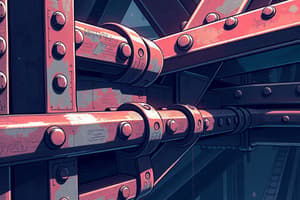Podcast
Questions and Answers
Which type of connection in steel structures involves melting the edges of the metal and fusing them together?
Which type of connection in steel structures involves melting the edges of the metal and fusing them together?
- Melted Connections
- Bolted Connections
- Riveted Connections
- Welded Connections (correct)
What type of connection in steel structures uses bolts to secure two pieces of metal together?
What type of connection in steel structures uses bolts to secure two pieces of metal together?
- Bolted Connections (correct)
- Welded Connections
- Melted Connections
- Riveted Connections
Why are riveted connections less commonly used today?
Why are riveted connections less commonly used today?
- Because they involve melting the edges of the metal
- Due to the higher labor cost associated with drilling and riveting (correct)
- Because they are not as strong as welded connections
- Because they are easier to disassemble
In which type of connection is one piece of metal laid on top of the other and melted together?
In which type of connection is one piece of metal laid on top of the other and melted together?
When are bolted connections often used in steel structures?
When are bolted connections often used in steel structures?
What makes welded connections different from bolted and riveted connections in steel structures?
What makes welded connections different from bolted and riveted connections in steel structures?
What are self-drilling screws and bolts used to join?
What are self-drilling screws and bolts used to join?
What is one of the factors influencing the design of connections in steel structures?
What is one of the factors influencing the design of connections in steel structures?
What does 'load path' refer to in connection design?
What does 'load path' refer to in connection design?
Why must the connection be designed to prevent excessive deflection of the structure?
Why must the connection be designed to prevent excessive deflection of the structure?
What environmental conditions should the connection be designed to withstand?
What environmental conditions should the connection be designed to withstand?
Why is detailing important in connection design?
Why is detailing important in connection design?
What does proper connection design ensure for a structure?
What does proper connection design ensure for a structure?
Which factor is NOT mentioned as influencing connection design in steel structures?
Which factor is NOT mentioned as influencing connection design in steel structures?
What is one of the main purposes of using self-drilling screws and bolts?
What is one of the main purposes of using self-drilling screws and bolts?
What happens if a connection has insufficient strength to support the load?
What happens if a connection has insufficient strength to support the load?
Study Notes
Design of Steel Structures: Connection Design in Steel Structures
Steel structures are widely used in construction due to their strength, durability, and versatility. The design of steel structures, particularly the connection design, plays a crucial role in ensuring the overall stability and functionality of the structure. In this article, we will discuss the connection design in steel structures and the factors that influence their design.
Connection Types in Steel Structures
There are several types of connections in steel structures, including:
-
Welded Connections: These connections are made by melting the edges of the metal and fusing them together. Welded connections can be either butt welded, where two pieces of metal are joined end-to-end, or lap welded, where one piece of metal is laid on top of the other and melted together.
-
Bolted Connections: These connections use bolts to secure two pieces of metal together. Bolted connections are often used when welding is not possible or desirable, such as in seismic zones or when the structure needs to be disassembled later.
-
Riveted Connections: Riveted connections use rivets to fasten two pieces of metal together. This type of connection is less commonly used today due to the higher labor cost associated with drilling and riveting.
-
Self-Drilling Screws and Bolts: These fasteners are used to join steel to steel or steel to concrete. They are used in applications where the fastener cannot be removed or must be installed in a hard-to-reach location.
Factors Influencing Connection Design
The design of connections in steel structures is influenced by several factors, including:
-
Load Transfer: The connection must be designed to transfer the loads from the structure to the foundation. The connection must have enough strength to support the load, and the materials must be chosen for their ability to transfer the load.
-
Load Path: The load path refers to the path the load takes through the structure. The connection must be designed to direct the load along the most efficient path.
-
Deflection: The connection must be designed to prevent excessive deflection of the structure. Deflection can result in damage to the structure or can reduce the capacity of the connection.
-
Durability: The connection must be designed to withstand the environmental conditions it will be exposed to. This includes wind, snow, and other weather conditions.
-
Detailing: The connection design must be detailed to ensure that it can be installed correctly. This includes marking the location for each bolt, welder, or rivet.
In conclusion, the design of connections in steel structures is a critical aspect of the overall design process. Proper connection design ensures that the structure is safe, strong, and functional. By considering factors such as load transfer, load path, deflection, durability, and detailing, engineers can create connections that meet these requirements and contribute to the successful construction of steel structures.
Studying That Suits You
Use AI to generate personalized quizzes and flashcards to suit your learning preferences.
Description
Explore the crucial aspects of connection design in steel structures, including various connection types such as welded, bolted, and riveted connections. Learn about the factors influencing connection design, such as load transfer, load path, deflection, durability, and detailing.




